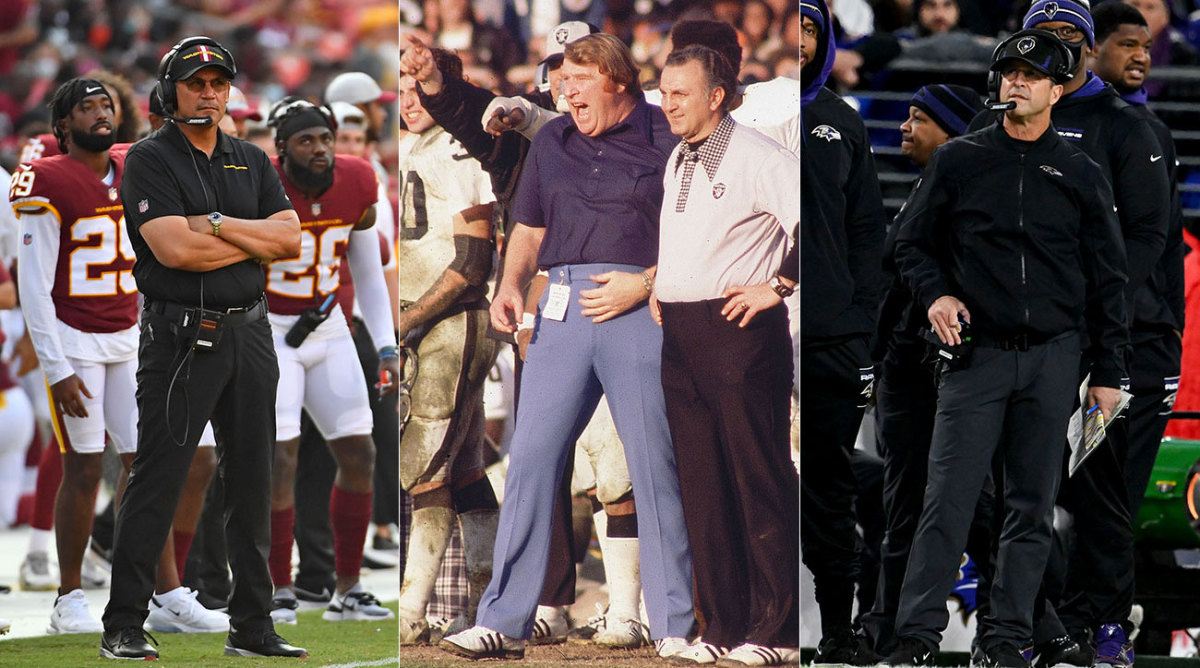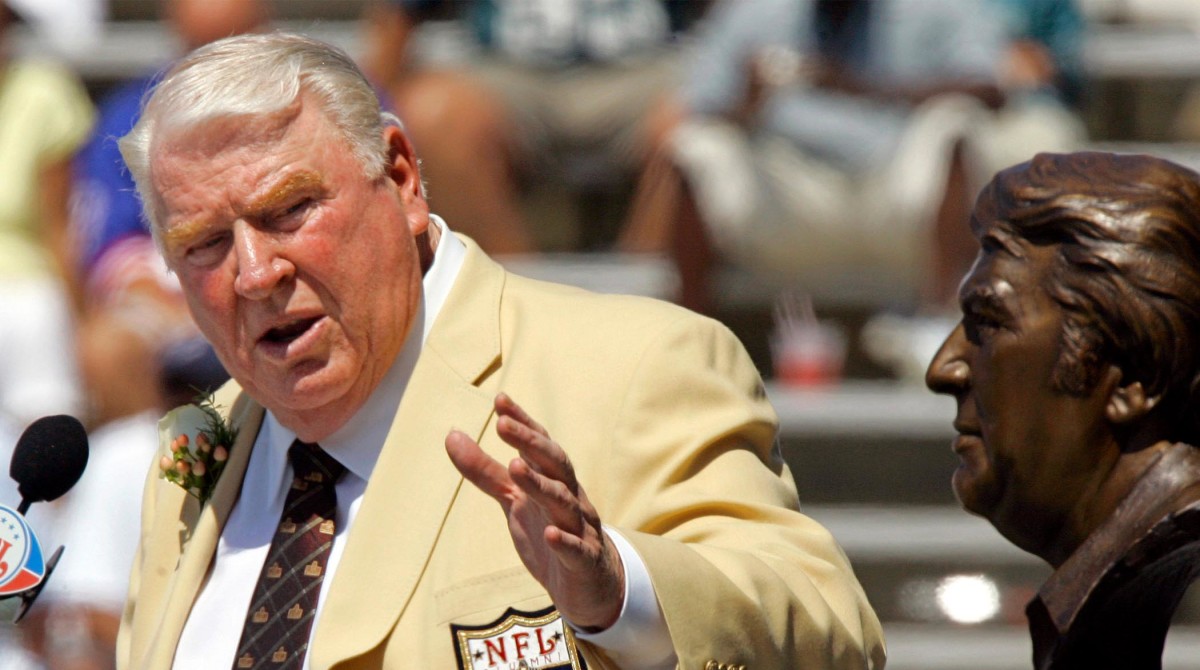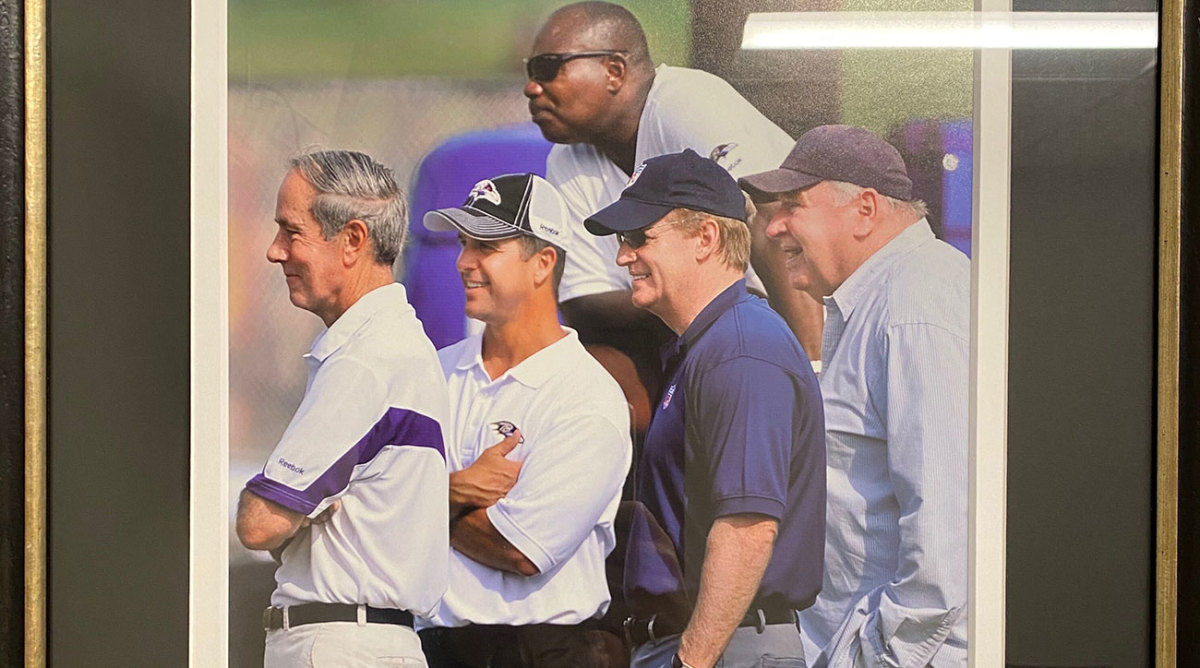John Madden Never Stopped Coaching
The official name of it is the “coaches subcommittee,” and anything you find from the NFL will officially list it as such, but you wouldn’t know that talking to the men who served on it.
To them, it was the Madden committee.
John Madden chaired it, and every last coach in the group cherished being a part of it, so that’s how they referred to it. They did that in reverence to Madden. They did that out of pride for their opportunity to work with him. They did that, most of all, because it really was his group.
“One hundred percent,” Ravens coach John Harbaugh said Tuesday night. “I probably wouldn’t have even done it, except it was the Madden committee, and Andy [Reid] was on it. For me, Andy was a big part of it. But beyond that, it was like, it’s the Madden committee. You can’t say no to John Madden. And then once you got on there, he was like the mother goose with her ducklings. Like he’d be walking into the room, and then we’d all be waddling in behind him, all five or six of us.
“We had it all organized: This is our case; this is what we’re going to say. John, you’re going to say this. Andy, you’re gonna talk about that; this is the tape we’re gonna show. Ron [Rivera], have you got your tape organized? And then when you say this, I’m gonna come in, and I’m going to make this point. He had it all strategized out like a game plan, and we’d walk in and try to do our role and not screw it up for him, you know?
“And if anybody ever asks, I do say, It’s the Madden committee.”
Madden died Tuesday morning at 85, and he left a rich and diverse legacy in the sport of football. My generation grew up with him on TV, seeing him and Pat Summerall as the standard bearers for football broadcasting, and watching the two call every big NFC game for CBS through an era in which the NFC won every Super Bowl. My kids identify with Madden through his unparalleled video game franchise.
But very clearly, it was the way in which my dad’s generation saw him—as a coach—that he saw himself. And that much was clear in the work that he did to the very end, with the coaches committee that would informally bear his name, and how its members saw him.
“There was a complete, total reverence for him because of who he was and how much he loved football, and just the way he talked about football,” said ex-Texans coach Bill O’Brien, now offensive coordinator at Alabama. “You could ask him anything. He was an open book. You could say, Hey, Coach, when the pass interference rule changed, can you go through that with us again and how that came about? And he would tell you the whole history of it.”
“It was funny because he wanted everything to be like it was our idea,” said Washington coach Ron Rivera. “And yet, you could tell he was the one driving the bus. I mean, he wanted it to be … it was from us. But you could tell, he was orchestrating everything.”
The coaches subcommittee routinely carries eight members, a quarter of the NFL’s head coaches, and those guys cycle on and off as hiring and firing across the league dictates. They weigh in on rules and big picture issues to give the competition committee, and the league as a whole, an idea of where coaches stand on key topics. It’s one of just two committees that’s not chaired by someone employed by the league or a team in an official capacity.
(It’s probably no coincidence that Madden chaired the other such committee, the player safety advisory panel, as well.)
And it’s there, really, where Madden was rolling up his sleeves and carrying out the final phase of his life’s work in football. Madden didn’t need to be doing it, of course. He was midway through his 80s, had accumulated generational wealth through his illustrious career and had every right to be, as most such people would, finishing up life on a beach somewhere with a drink in his hand.
Instead, he’d be yelling with guys like Harbaugh and Rivera and O’Brien over the state of holding calls in the NFL.
“He always hated inconsistency in holding,” Harbaugh said, laughing. “His basic thing was, either let them hold as much as they want, or don’t let them hold at all. He’s kind of black and white about the rules.”
“He didn’t like the fact, I think, that the rules were kind of ambivalent, that they put too much pressure on the referees to have a definition, to find a definition,” Rivera added. “He just felt like the rules should be clear-cut.”
That was just one of his things.
Another was his hatred of illegal contact downfield, which some found irony in given the way his old Raiders teams played. A big one was his concern on the state of line play. “He loved offensive line—loved the offensive line—and he wanted to make sure that we were taking care of those guys. … He thought it could be better,” O’Brien said. “He always talked about offensive and defensive line play, how he felt it was deteriorating,” Rivera added.
“He was always really passionate just about every issue,” Harbaugh said. “I mean everything really mattered to him.”
Being in the weeds with the guys on the committee was one way that showed Madden wasn’t just there to take a victory lap as a legend of the game. But it certainly wasn’t the only way he proved to those guys that he cared.

Madden last coached 43 years ago, having walked away at 42 with more than half his life left to live. Still, he never left coaching—and it was the NFL’s coaches he wanted to stay most connected to. The way he looked after the guys on the committee was proof of it.
“It really did feel like you were his guys,” Harbaugh said.
Rivera first met Madden as a high school football player, when he was out with his buddies at an ice cream parlor and arcade at the old Edgewater Packing Company on Cannery Row in Monterey, Calif. The young linebacker and Raiders fan spotted the then Oakland coach in a crowd, introduced himself, and Madden responded, “You look like a football player.” Rivera responded, “I am, and someday I’m going to play in the NFL.” Madden then grabbed a piece of paper and signed it, “Dear Ron, best wishes and good luck, John Madden.”
Rivera still has that piece of paper in a scrapbook at his mom’s place in northern California, and he got to remind Madden of it plenty as his relationship with the legend grew.
Their bond really took off in 2013. After Rivera went 6–10 and 7–9 in his first two years as coach of the Panthers, then owner Jerry Richardson finished an end-of-year review with his head coach by saying, “You know, Ron, I think you should have a mentor.” Richardson had, once upon a time, been roommates with Madden at a college all-star game, the two had stayed in touch, and so the owner slid Madden’s info, written on a small slip of paper, across the table. “I’ve already talked to Coach,” Richardson told Rivera. “He’s expecting your call.”
Rivera’s early conversations with Madden gave birth to Riverboat Ron.
Before Rivera’s first trip out to see him, Madden asked him about, as the now Washington coach recalls it, his team’s 3–13 record in games decided by six points or fewer. He told Rivera to go back and study those games, and “see if you could’ve done something different.” Rivera pointed out that in one game he’d kicked a field goal to push a lead to six, then lost by one. In another, he punted to play the field-position game, and the other team drove the field.
“What were you thinking?” Madden asked.
“I was doing everything by the book,” Rivera responded.
“By the book?” Madden responded. “What book? Excuse me? Ron, there is no book. You’ve played enough football; you’ve coached enough football to go on your gut instinct. Go on your experience. Don’t do it by the book. That’s the safe thing. Do the right thing.”
Sure enough, in Week 2 of 2013, Rivera called for another field goal to push a three-point lead to six with 1:42 left. That made it 23–17. The Bills responded by driving the field and winning the game 24–23, which kept Rivera up that night second-guessing himself. The next week, against the Giants, the Panthers went for it on a fourth-and-1 from the New York 2 in the first quarter, Mike Tolbert slammed it into from the end zone, and Carolina won 38–0.
“And from that point on, every time I got to fourth down, I really thought about whether to go or not,” Rivera said. “And if I felt good about it, I did it, and if not, we punted. But I stopped doing it by the book and started doing it by what I thought was right.”
Which signifies just one story of Madden helping coaches. There were plenty of others involving guys that served on his committee.
O’Brien had a similar story of the first time he met Madden. He played football at Brown with Madden’s son Joe, who was a few classes head of O’Brien, and would run into him at an annual party John would throw for all Brown athletes (not just the football players).
And as Rivera did, O’Brien eventually got to circle back and talk to Madden about that, after Matt Millen introduced the two when O’Brien left Penn State for the Texans. O’Brien then found his way onto the Madden committee, and a relationship grew from there. O’Brien would call for advice, whether it was something on the field he was trying to work out or an off-field issue that might be complicated to work through. And over time, he noticed that he was starting to incorporate Madden’s philosophies into his own program.
“One of the things he said to his team all the time was he didn’t have a lot of rules,” O’Brien said. “He had three, and he would tell me this. … He said he wanted them to show up on time, he wanted them to pay attention, and he wanted him to play like hell when he asked them to play like hell. He would always say that to me. He’s like, ‘You can’t have too many rules.’ And as time evolved in Houston, I actually had less and less rules.”
When Houston fired O’Brien in 2020, Madden called him right away and said to him, “We need guys like you in the NFL.” It’s a gesture O’Brien says now that he’ll never forget—and the one regret O’Brien carries from their relationship is that, because he went back to college football this year, he didn’t get to talk to Madden as much over the last year and show his appreciation for all Madden had done for him.

These coaches treated Madden like a rockstar because, in the football world, he was one.
Harbaugh has, for years, been asking Lisa Dixon, special assistant to Ravens owner Steve Bisciotti, for a print of a picture she has hung in her office. It’s about a decade old, and it’s got team president Dick Cass, ex-GM Ozzie Newsome and commissioner Roger Goodell standing around the Ravens’ coach on the sideline, with Madden right there in a ball cap—and I don’t need to tell you whose image has Harbaugh wanting that copy of it so badly.
“I just remember, we’re sitting there, laughing, having a conversation, watching our team. We’ve got Ray [Lewis], and he’s a legend; Ed [Reed] is out there; we had this really good team,” Harbaugh said. “But I’m thinking, ‘Oh my God, I’m standing here, laughing with John Madden.’”
Harbaugh then added, “I want that picture so bad. I want it so bad. It’s just the best.”

The other guys have their keepsakes from Madden, too.
Rivera has a trove of notes from nearly 10 in-person, one-on-one summits with Madden, and he’s shared those very sparsely. But, he says, “I’ll read them, and I go back to them and there’s some great stories in there.” Ex-Cowboys QB Troy Aikman is one of the lucky few to get to see those recently, and Aikman’s returned the favor to Rivera by passing along his own stories about the legendary coach and broadcaster.
And O’Brien, believe it or not, has held on to every voicemail Madden ever sent him, which gave him the chance to prove to his dad that he was, in fact, friends with the guy.
“I don’t know why [I saved them], I just did,” O’Brien said. “And I’d go home in the summers and tell my dad, I’m like, ‘Dad, I’m friends with John Madden.’ And my dad, this guy is 90 years old from Boston. And so I’d play him a voicemail. I remember telling him one time, I said, ‘Dad, coach Madden wants us to make sure that we stay back on the sidelines, that we control our sidelines better as coaches. That we’re not out on the field.’
“And my dad would always laugh at that because he would say, ‘What I loved about John Madden is he was on the field.’”
It’s a funny story, but also Madden had continued to learn about the game through his experiences, and that wasn’t just learning up until his 1978 departure from the Raiders—it was continuing to learn regardless of his involvement, and then passing that on to others.
In that way, Madden kept coaching until the end. For a while, it was as a broadcaster who could synthesizes and dramatize a complex, difficult game, and distill it down to give the laypeople watching something both easy and entertaining to learn and follow. Along the way, it was also through a video game that revolutionized the way kids playing could pick up on strategy and nuance that was once reserved for those at far more advanced levels.
Most significantly, though, it was always with those who followed in his footsteps on NFL sidelines.
“What greater definition of a coach than a coach who coaches and connects with his players and his fellow coaches?” Harbaugh said. “That’s one level, right? Then, he’s a coach that connected the game to people, and taught the game to the fans. So people that watched the broadcast, he taught, he coached them. He taught them football, how to understand the game, how to love the game. And then, after he got done broadcasting, coached and taught people to love the game through the video game. And that’s how the younger generation knows about him. That’s how younger kids have learned to love football.
“So you’re talking about three generations, in different ways. I always say, the best coaches are the ones that have the broadest range, whether it’s the ability to coach high school kids, college kids, pros, 38-year-olds, coach your coaches, coach your owner, whatever it is. This guy coached everybody.”
So it was that Madden’s last act of coaching would be coaching the guys on that committee.
They learned from him, and followed him, the same way Madden’s Raiders once did, and when it came time to go to fight for something, they knew he had their back because those were his guys.
“The subcommittee was made up of awesome guys,” O’Brien said. “Obviously, it was run by coach Madden, it was run by Andy Reid and then we would consult [Bill] Belichick on things. But it didn’t seem like our voices were always heard, relative to what we recommended to the competition committee. That frustrated him sometimes, and one of the things he’d say, ‘I’m gonna stay involved in this until we can get some of these things done correctly.’”
And in that sense, half a lifetime after hanging up his whistle, Madden kept coaching right up until the very end.
More on John Madden:
